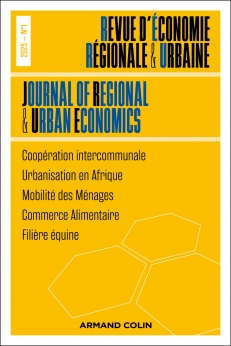
REVUE D'ÉCONOMIE RÉGIONALE ET URBAINE (1/2025)
Pour acheter ce numéro, contactez-nous
Recevez les numéros de l'année en cours et accédez à l'intégralité des articles en ligne.
Une méthode originale d’estimation de l’impact économique, la méthode de la dépendance, est appliquée à la filière équine dans quatre départements français (Ain, Allier, Maine et Loire, Bouches du Rhône). Les enjeux sont à la fois théoriques (estimation des effets court et long terme en intégrant théories keynésienne et coûts de transaction) et empiriques (mise au point d’une méthode souple à un niveau territorial et à une filière soumise à des chocs variés). Les résultats obtenus montrent que la méthode de la dépendance donne des résultats comparables à des méthodes plus classiques en économie régionale (base économique) mais d’un ordre de grandeur supérieur en raison de la prise en compte des effets de long terme.
The dependency method was an original method to estimating the economic impact. It was applied to the horse industry in four French departments (Ain, Allier, Maine-et-Loire, Bouches-du-Rhône). The issues are both theoretical (estimating short and long-term effects by integrating Keynesian theories and transaction costs theory) and empirical (developing a flexible method at a territorial level and for a sector subject to various shocks). Surveys were carried out with a sample of companies to estimate their jobs and their dependence on the equine sector. An overall dependency score is estimated from three components: short-term dependency or relative importance of the horse industry in outlets; medium and long-term dependence, reflecting the company’s ability to adapt to changes in the horse industry; geographical dependence, which corresponds to the territorial constraints suffered by the company within the department studied. Results highlights that the dependency method gives estimations comparable to more traditional methods in regional economics (as the economic basis); but with an order of magnitude higher due to the consideration of long-term effects. Two sets of explanations can be put forward to explain the higher level of estimates by the dependence method. On the one hand, the theoretical foundations of the 2 methods are different: while dependency is a "dynamic" method (which captures the effects of transformation of the productive system), the classic models of regional economy (economic base, input-output) quantify only short-term Keynesian income effects. On the other hand, there are reasons related to the scope of activities: only professionals of the sector for economic base models; consideration of the amateur sector in the surveys implemented by the dependency method.

